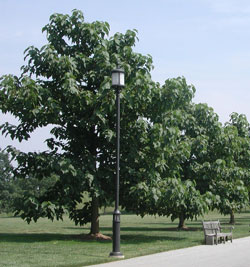Resource Library
Plant of the Week: Empress Trees
The University of Arkansas System Division of Agriculture does not promote, support or recommend plants featured in "Plant of the Week." Please consult your local Extension office for plants suitable for your region.
Plant of the Week
Empress Trees
Latin: Paulownia tomentosa

"There's a sucker born every minute," or so claimed P.T. Barnum. Though he may not have actually coined this phrase, it does encapsulate a truism. People can be so gullible sometimes, especially when they want to believe something that seems too good to be true. The oft-promoted Empress tree (Paulownia tomentosa) isn't really a very good landscape tree but you'd never know it by the hype that has been used to promote it.
Paulownia is a fast-growing deciduous tree, routinely making 8- to 10 feet of growth a year as a well-established seedling. Five-year-old trees will approach 20 feet in height. In this juvenile state of growth, the leaves are catalpa-like but much bigger, often to 16 inches across. As trees mature, the leaf size becomes more modest with 6- to 8-inch wide and long leaves more common. Leaves turn black with the first frost.
Paulownias branch freely and have a rounded form at maturity. Though capable of attaining a height of over 60 feet, most are less than 40 feet tall and wide.
The purple, 2-inch long foxglove-like flowers of Paulownia appear in April before the leaves are produced, and illustrate why this species has been considered the most cold hardy of the woody Scrophulariaceae, the family to which it is usually assigned. The round, fuzzy flower buds form in late summer and are prominently displayed at the ends of branches as a 10-inch tall panicle through the winter.
Following flowering, an inch-long round capsule is formed from each flower. These capsules persist through the following winter and give the tree an unkempt appearance. In the spring they split open and release tiny winged seeds upon the world. A mature tree can produce upwards of 20 million seeds.
The Empress tree enjoyed a kind of sylvan superstar status on the back page of the Sunday supplement to newspapers across the nation during the 1980s. In the oft-seen ads the hucksters promised the tree would grow 22 feet in a single year and provide almost instant shade. While it does grow incredibly fast, they failed to mention its brittle wood and overall untidiness as a landscape tree.
During this same period the tree became popular for reforestation on reclaimed strip mining sites in Kentucky and surrounding states. From these reforestation efforts sprang the American Paulownia Association that began promoting the tree as a path to riches growing timber logs to ship to Japan where it is claimed there exists an almost insatiable demand for the lumber. The lumber is lightweight, strong and good for cabinetry and furniture building, but its use seems to be largely confined to Japan.
In the latest iteration of Paulownia promotion, the tree is now being touted in some tropical countries as a way for individuals to reduce their carbon footprint by sponsoring plantations where it will be grown to sequester carbon dioxide.
But for the boosterism surrounding the tree, there are an equal number of detractors. In many parts of the southeastern states, this Chinese native has escaped cultivation and is listed as an invasive species. Its place in the ecosystem is as a pioneer species, so it favors highly disturbed sites such as strip mines and roadsides, but occasionally it will find its way to the woodsy margins of rivers and streams. Because of its need for full sun, Paulownia is a poor competitor with oaks, hickories, pines and other trees of a mature forest so it does not spread into established forests.
Paulownia is hardy to minus 10 degrees F, making it a zone 5 plant. However, unseasonal weather often result in dieback at the northern end of this zone. But even if frozen to the ground, the tree will sucker from the trunk and regrow quickly. This is an interesting tree from many aspects but is usually best admired in another person's yard or in the city park, not your own.
By: Gerald Klingaman, retired
Extension Horticulturist - Ornamentals
Extension News - November 6, 2009
The University of Arkansas System Division of Agriculture does not maintain lists of retail outlets where these plants can be purchased. Please check your local nursery or other retail outlets to ask about the availability of these plants for your growing area.